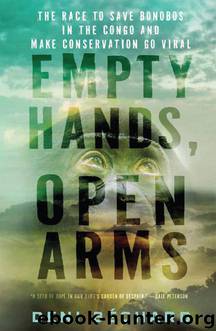Empty Hands, Open Arms by Deni Bechard

Author:Deni Bechard
Language: eng
Format: mobi
ISBN: 9781571318497
Publisher: Milkweed Editions
Published: 2013-11-08T08:21:10+00:00
Territory and Power
While bonobos as symbols might sound quaint in the context of rainforest villages or community building, the importance of the coalitions they represent shouldn’t be minimized. Traveling, I’ve often encountered disillusioned youths who have worked with NGOs, whether humanitarian or conservation, and who are heading home, finished with saving the world. Their stories are remarkably similar: infighting, power grabs, projects that have more to do with the people running them than with what or whom they are trying to protect.
If the stories told by those involved with BCI and Vie Sauvage are to be believed, the greatest challenge to the conservation work being done by BCI and its Congolese partners isn’t government ministries, corrupt officials, or decayed infrastructure, but rather competing NGOs. As Sally explained, BCI’s greatest challenges began with the arrival of the large conservation NGOs that came to the Congo under the auspices of USAID. With the end of the Second Congo War, USAID initially decided to allocate fifty-three million dollars to the Congo basin, funds that were to be matched by hundreds of millions more from donors and governments abroad. The resulting project, the Congo Basin Forest Partnership (CBFP), set about dividing the Congo basin into twelve “landscapes” and putting the big international NGOs—the BINGOs—in charge.
CBFP’s mandate emphasized partnership and resource-sharing with those already working on the ground. However, there were some regions where none of the BINGOs had worked, and while BCI was one of the few organizations already operating in these regions, it was small, nothing compared to the larger, more established structures of the World Wildlife Fund and the African Wildlife Foundation. BCI’s 2011 revenue reached $1 million in 2011, compared to $26 million for AWF and $238 million for WWF. BCI met with AWF, which had yet to work within the Maringa-Lopori-Wamba landscape (containing Kokolopori), providing it with information for its bid to become landscape administrator. And yet while AWF’s proposal used information from one of BCI’s studies of the region, it didn’t credit BCI, and shortly after AWF had been made landscape administrator, it distanced itself from BCI. As Alden Almquist recalls, the person he had worked with at AWF told BCI that the subcontracting was being organized in Kinshasa.
In the decade that followed, AWF would resist sharing funding with BCI, preferring to set up its own projects. When BCI petitioned to receive a portion of the funds directly, Sally recalled how USAID told her that BCI had to work through AWF. Between 2002 and 2011, the United States government invested $98 million in the twelve CBFP landscapes (at least $50 million of which was matched by foreign donors); of the millions that AWF received for the landscape that contained the Kokolopori Bonobo Reserve, only $3,650 went directly to BCI—in 2004, to support a survey. Even though the Kokolopori Bonobo Reserve was an integral and ecologically rich part of the landscape and made a nationally gazetted protected area in 2009, it was left off AWF’s CARPE/CBFP map of the landscape for several years.
Download
This site does not store any files on its server. We only index and link to content provided by other sites. Please contact the content providers to delete copyright contents if any and email us, we'll remove relevant links or contents immediately.
The Vikings: Conquering England, France, and Ireland by Wernick Robert(79057)
Ali Pasha, Lion of Ioannina by Eugenia Russell & Eugenia Russell(39883)
The Vikings: Discoverers of a New World by Wernick Robert(36797)
The Conquerors (The Winning of America Series Book 3) by Eckert Allan W(36498)
Cecilia; Or, Memoirs of an Heiress — Volume 1 by Fanny Burney(32002)
Cecilia; Or, Memoirs of an Heiress — Volume 3 by Fanny Burney(31425)
Cecilia; Or, Memoirs of an Heiress — Volume 2 by Fanny Burney(31370)
Empire of the Sikhs by Patwant Singh(22733)
Hans Sturm: A Soldier's Odyssey on the Eastern Front by Gordon Williamson(18302)
The Secret History by Donna Tartt(18053)
Cat's cradle by Kurt Vonnegut(14694)
Sapiens: A Brief History of Humankind by Yuval Noah Harari(13918)
Pimp by Iceberg Slim(13694)
Talking to Strangers by Malcolm Gladwell(12797)
Norse Mythology by Gaiman Neil(12748)
Leonardo da Vinci by Walter Isaacson(12743)
Underground: A Human History of the Worlds Beneath Our Feet by Will Hunt(11806)
4 3 2 1: A Novel by Paul Auster(11741)
The Radium Girls by Kate Moore(11564)
